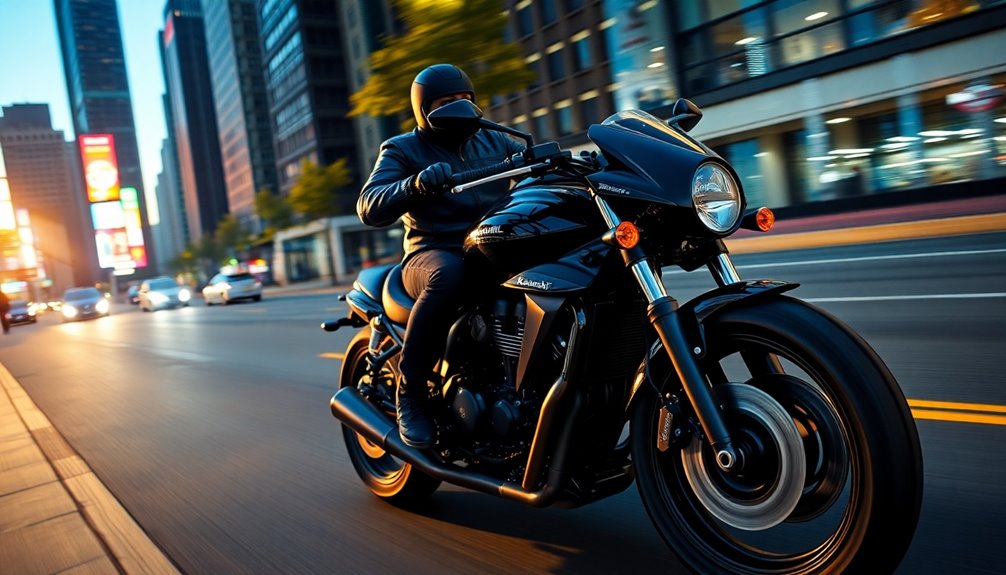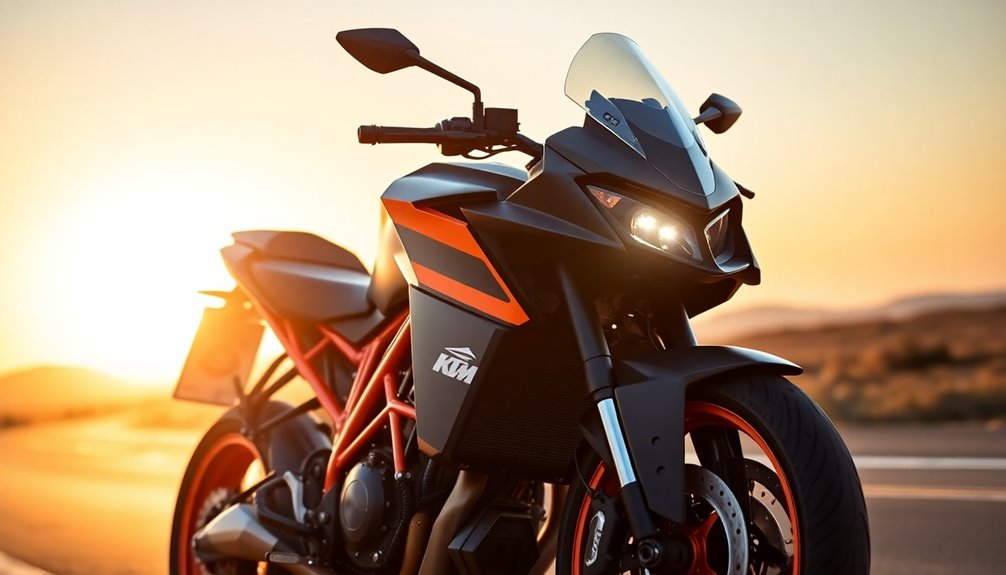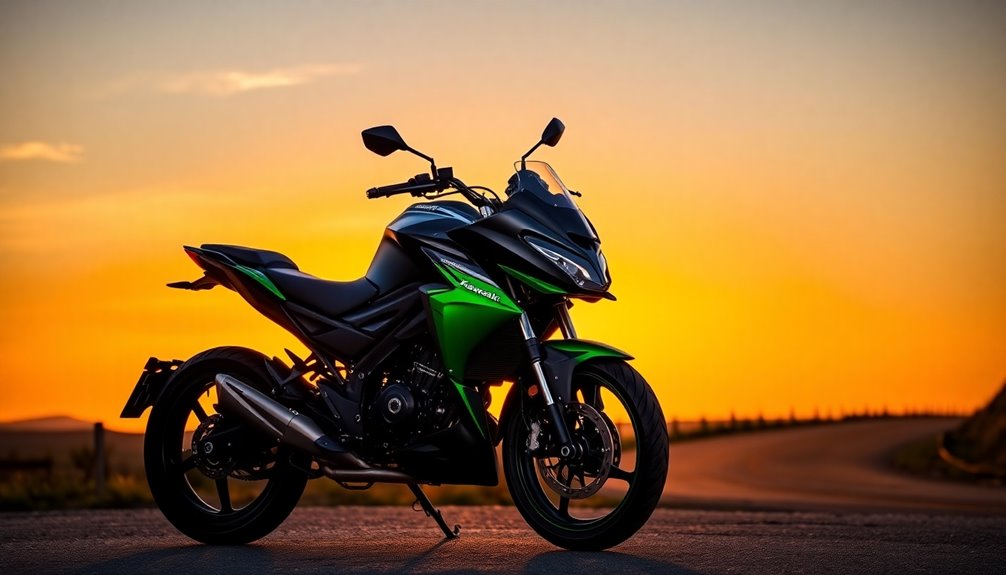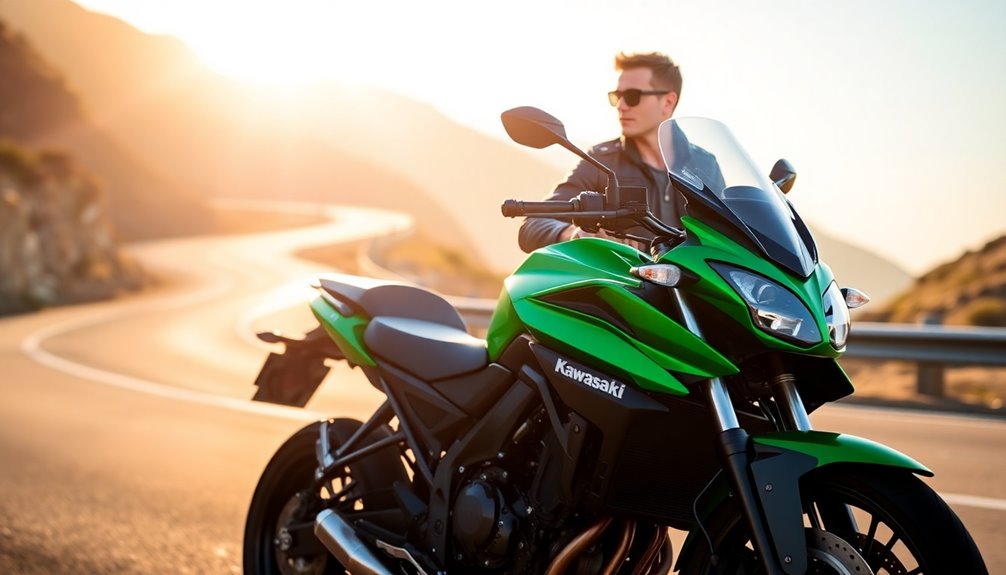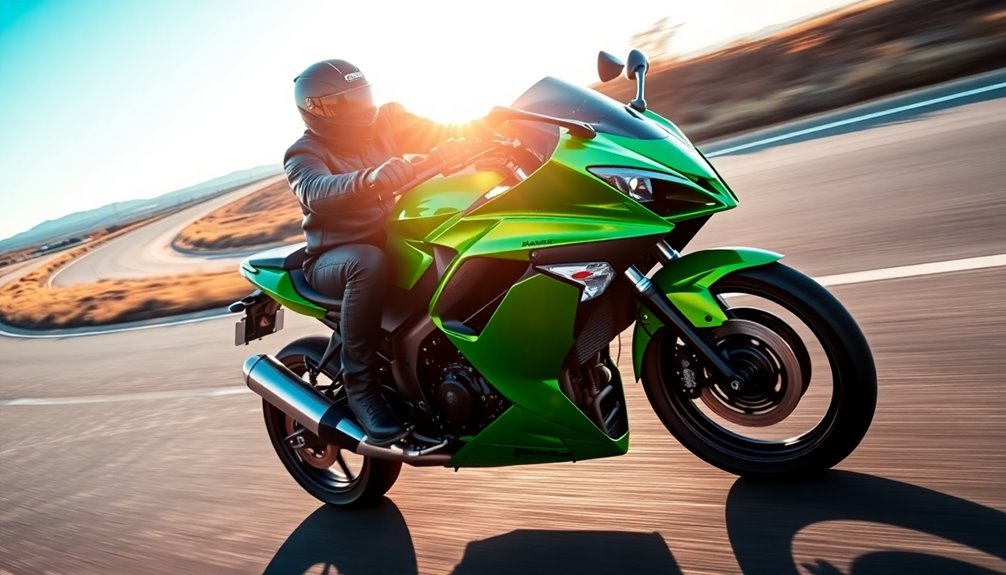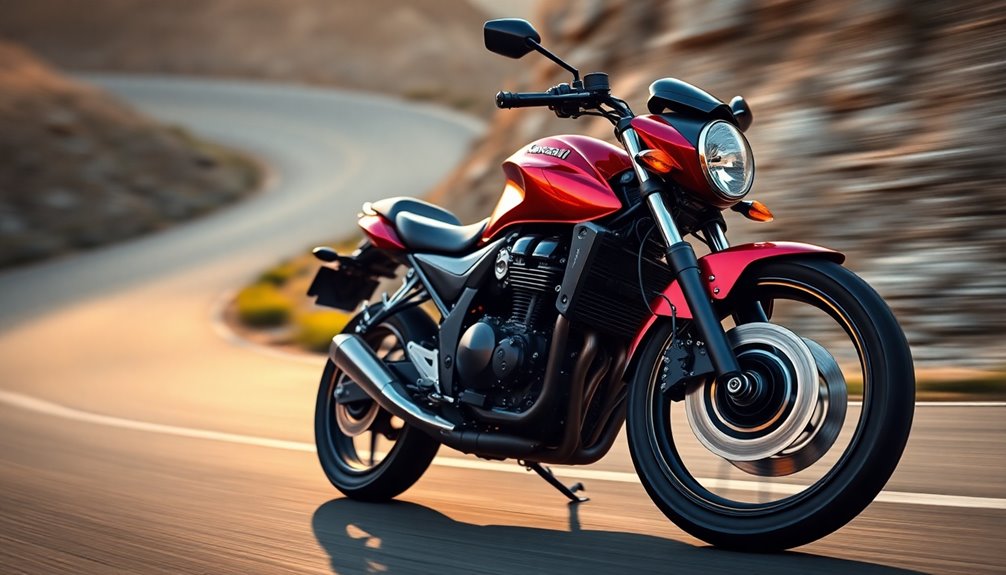The Kawasaki Vulcan S is the perfect blend of urban cruising comfort and sporty performance, boasting a top speed of 120 mph. You'll appreciate its 649 cc engine, delivering 61 hp and impressive acceleration. With a realistic cruising speed around 108-110 mph, it excels in city traffic and long rides alike. The adjustable Ergo-Fit system lets you customize your seat, handlebars, and footpegs for maximum comfort, tailored to your height. Plus, its stable handling keeps you confident at any speed. Stick around, and you'll discover even more reasons to consider the Vulcan S for your next ride.
Key Takeaways
- The Kawasaki Vulcan S achieves a top speed of 120 mph, with realistic speeds around 108-110 mph for most riders.
- Its sporty performance is complemented by quick acceleration, reaching 0-60 mph in just 4.21 seconds.
- The rear-biased weight distribution enhances acceleration, making it agile for urban riding and stop-and-go traffic.
- Stable handling and a low seat height of 27.8 inches improve maneuverability, adding to its urban cruiser appeal.
- Exceptional fuel economy of 53.7 mpg makes it practical for daily commuting without sacrificing performance.
Ergonomic Seat Design Benefits Riders

The Kawasaki Vulcan S is designed with rider comfort in mind, offering an impressive range of ergonomic features that cater to different body types. With the Ergo-Fit system, you can easily adjust the seat, handlebars, and footpegs to suit your unique build, accommodating riders from 4'11" to 6'1". This flexibility helps you achieve a comfortable riding position, minimizing fatigue and strain during your journey. Additionally, the Vulcan S has a variety of seat configurations to further enhance comfort and fit.
The Vulcan S also offers seats equipped with gel pads for extra cushioning, particularly in the extended reach seat. You'll appreciate the Corbin seats, which feature Comfort Cell foam that conforms to your body over time. Their ergonomic shaping eliminates pressure points, enhancing your comfort on longer rides.
Moreover, lumbar support is a key feature that helps maintain good posture, reducing back pain during extended outings. Seats designed with this support alleviate tension in your back and legs while increasing overall comfort.
With multiple customization options, you can personalize your ride to match your style and comfort needs, making the Vulcan S a truly adaptable and rider-friendly motorcycle.
Performance Metrics Breakdown
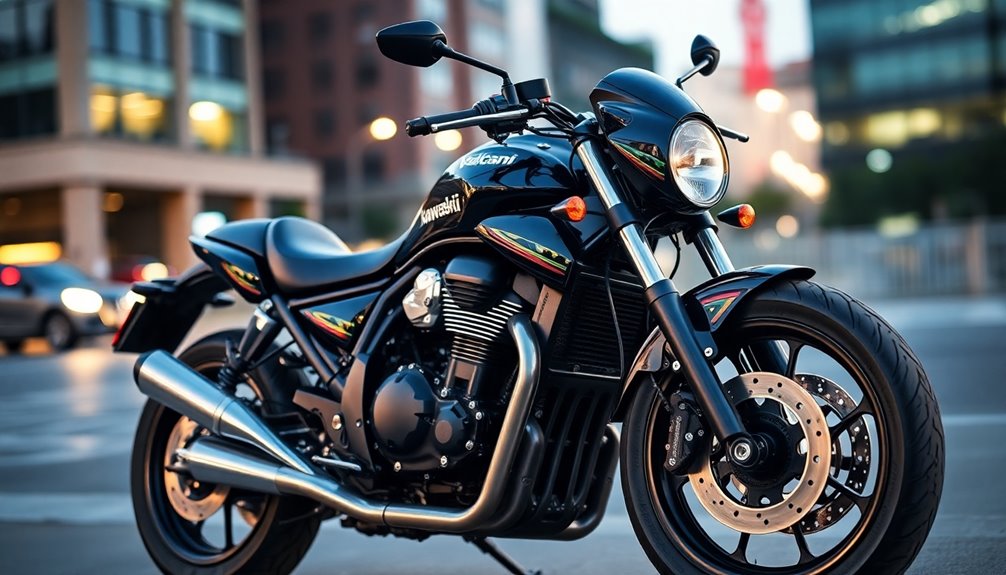
When you look at the Kawasaki Vulcan S, its maximum velocity of 120 mph and impressive 0-60 mph time highlight its performance. The bike's aerodynamic design plays a crucial role in achieving these metrics, helping you cut through the wind with ease. Additionally, the Vulcan S boasts a remarkable acceleration of 5.83s, which further underscores its sporty capabilities. Understanding these performance metrics can enhance your riding experience and appreciation for the Vulcan S.
Maximum Velocity Achieved: 120 Mph
Achieving a top speed of 116.8 mph, the Kawasaki Vulcan S showcases impressive performance metrics for riders seeking both thrill and stability. Most riders can realistically hit around 108-110 mph, but with an aggressive tuck, you can push it to the limit. This translates to an exhilarating 186 km/h, perfect for those who crave speed.
The Vulcan S delivers smooth power through its engine, generating a peak horsepower of 61 hp at 7500 rpm and 63 Nm of torque at 6600 rpm. However, be mindful that power drops off beyond 8000 rpm, so shifting gears at the right time is essential for optimal speed. Its performance is enhanced by a slight increase in midrange performance compared to other models in its class.
You'll find it stable and vibration-free as you approach top speed, although an aerodynamic deficit becomes noticeable above 80 mph.
The weight distribution leans towards the rear, which, combined with its lighter build compared to models like the Ninja 650 and Z650, plays a crucial role in both acceleration and top speed.
Reaching 100 mph takes about 12.55 seconds, highlighting the Vulcan S's efficiency and performance capabilities on the open road.
To 60 Mph Time
Accelerating to 60 mph in just 4.21 seconds, the Kawasaki Vulcan S demonstrates impressive responsiveness and power. This quick time showcases the bike's robust 649 cc, 4-stroke, 2-cylinder engine, which delivers a peak horsepower of 61 hp at 7500 rpm and peak torque of 63 Nm at 6600 rpm. The fuel injection system ensures optimal performance, allowing for an exhilarating ride. Additionally, the Vulcan S benefits from the DFI fuel injection system, which contributes to an impressive fuel economy of 53.7 mpg.
When you take off, the Vulcan S excels from a standstill, clocking in at just 1.54 seconds for 0-30 mph. This low-end performance is crucial for urban riding, giving you the edge in stop-and-go traffic.
As you push through the gears, you'll find that shifting into fifth gear provides the best acceleration to hit that 60 mph mark swiftly.
While the bike's weight does affect acceleration compared to lighter models like the Ninja 650, the smooth power delivery and mid-range torque still make highway overtakes effortless.
With a 0-70 mph time of 5.53 seconds, you'll have no trouble merging or passing on the highway. Overall, the Vulcan S offers a thrilling blend of power and agility for urban cruising.
Aerodynamic Design Influence
Understanding aerodynamic design is crucial for maximizing the performance of the Kawasaki Vulcan S. The bike's top speed reaches around 116.8 mph, but most riders experience a more realistic top speed of 108-110 mph due to aerodynamic limitations. Once you exceed 80 mph, aerodynamics play a significant role in both top speed and acceleration.
Compared to its sportier siblings, the Z650 and Ninja 650, the Vulcan S has less efficient aerodynamics, which impacts its high-speed performance. The bike's lower stance and longer wheelbase contribute to its aerodynamic profile, but these features also affect agility at high speeds. Additionally, the ERGO-FIT design allows for customization of rider comfort, which can influence performance based on individual riding positions.
Your riding position can further influence performance; tucking in helps reduce wind resistance, enhancing speed. While the 649 cc parallel-twin engine delivers solid mid-range torque, its tuning emphasizes acceleration over peak speed, making it less optimized for high-end performance.
Additionally, the Vulcan S's heavier weight and rear-biased weight distribution can hinder acceleration. The 6-speed transmission, although smooth, lacks lower gearing for added thrust.
Ultimately, understanding these aerodynamic influences can help you better appreciate the Vulcan S's unique blend of cruiser comfort and sporty characteristics.
Owner Feedback on Comfort
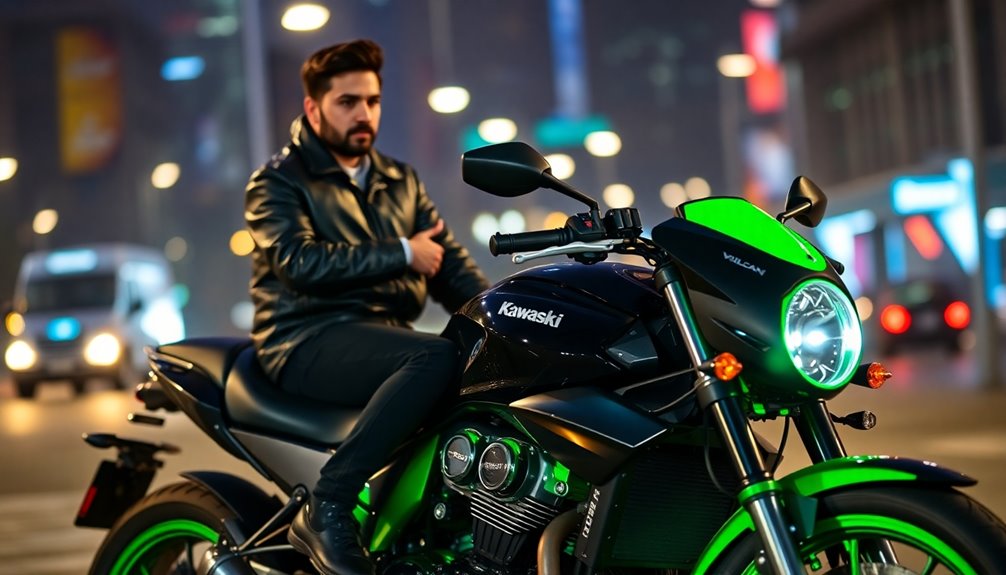
Riders often praise the Kawasaki Vulcan S for its impressive comfort, thanks to its customizable ergonomics. The Ergo-Fit system offers 18 possible configurations, allowing you to tailor the seat, footpegs, and handlebars to your exact preferences.
Whether you prefer a reduced, mid, or extended reach, you'll find a seating position that suits your style. The smooth power delivery from the 649cc engine enhances your riding experience, minimizing fatigue during long journeys. With a low seat height of 27.8 inches, you can enjoy stability and confidence, especially when cornering. Riders report feeling a "stay put" sensation, thanks to the well-designed seating position.
You'll appreciate the adjustable rear shock, which allows you to fine-tune your ride quality for extended comfort. The 41mm telescopic fork and rear shock provide excellent suspension, ensuring a balanced journey over various terrains. Additionally, the Vulcan S features a liquid-cooled engine, which helps maintain optimal performance even in varying weather conditions.
Many riders have noted that they experience no aches or stress, even after a full day of riding. Overall, the Vulcan S not only offers a comfortable ride but also allows for long-term customization to enhance your comfort on the road.
Rider Insights: Real-World Experiences
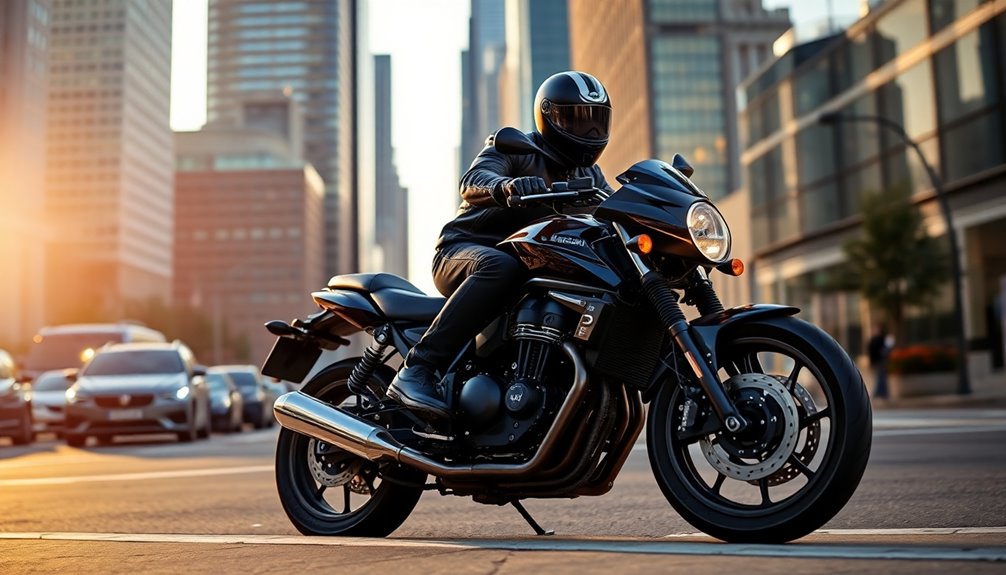
Experiencing the Kawasaki Vulcan S firsthand reveals a blend of power and agility that many riders appreciate. With a 649cc parallel-twin engine, you'll feel its smooth power delivery as you accelerate from 0-60 mph in just 4.21 seconds. The mid-range torque makes highway overtakes effortless, especially when you're cruising at 60-70 mph.
You'll find that the top speed hovers around 108-110 mph in real-world conditions, providing plenty of thrill for urban riding. The lightweight design enhances handling, making every turn a breeze.
The Vulcan S isn't just about speed; its sportbike-derived chassis ensures light and responsive handling. Thanks to the ERGO-FIT® system, you can easily adjust the riding position to suit your height and style, making it a comfortable choice for extended rides.
With a quarter-mile time of 13.03 seconds at 103 mph, it delivers impressive performance without feeling harsh or jerky.
Plus, the fuel economy can reach the high 50s mpg, making it practical for daily use. Riders consistently praise the confident traction and stability, thanks to the lower center of gravity and sportbike-influenced wheels.
Market Positioning Against Rivals
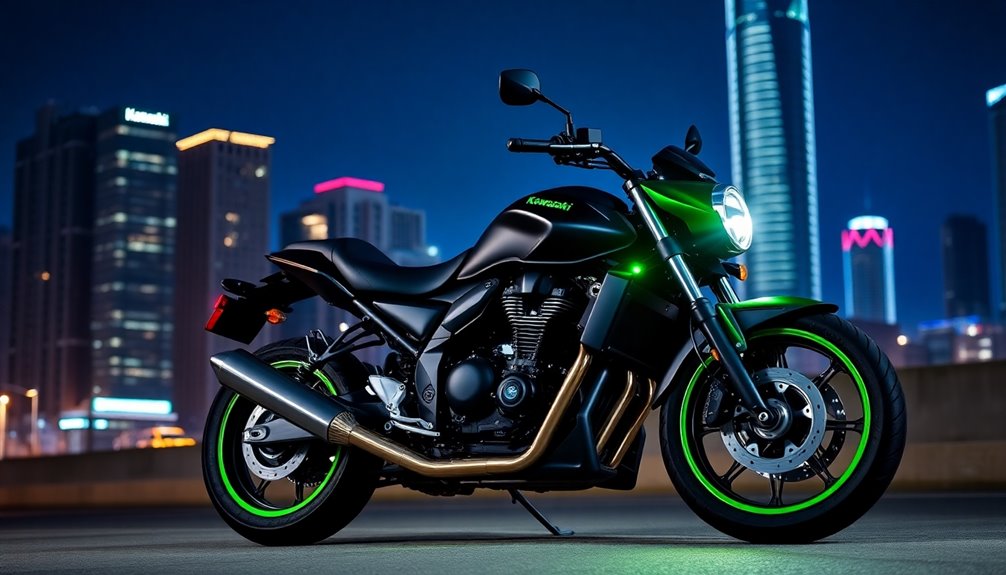
While the Kawasaki Vulcan S stands out in the cruiser segment, it faces stiff competition from several notable rivals. The Honda Rebel 500 offers an affordable, beginner-friendly design, while the more traditional Yamaha Star Venture targets long-distance riders with its larger engine and added features. You'll also find the Kawasaki W800 Street and Eliminator in the same price range, each with their unique styling and performance characteristics.
Starting at approximately $7,349, the Vulcan S is competitively priced against these models. The ABS version comes in at around $7,749, keeping it accessible for those looking for a blend of sporty and cruiser elements. Its sportbike-derived chassis and adjustable ERGO-FIT ergonomics set it apart, appealing to various rider sizes and preferences. Additionally, the Vulcan S boasts a low seat height of 27.8 inches, enhancing comfort and stability for riders of all sizes.
The Vulcan S primarily targets beginner riders, daily commuters, and casual cruisers. Its smooth engine and agile handling make it perfect for city streets, whereas competitors like the Honda Rebel focus more on entry-level riders.
In this crowded market, the Vulcan S successfully carves out a niche, offering a unique mix of comfort, style, and performance that keeps riders coming back for more.
Performance Enhancements and Customizations
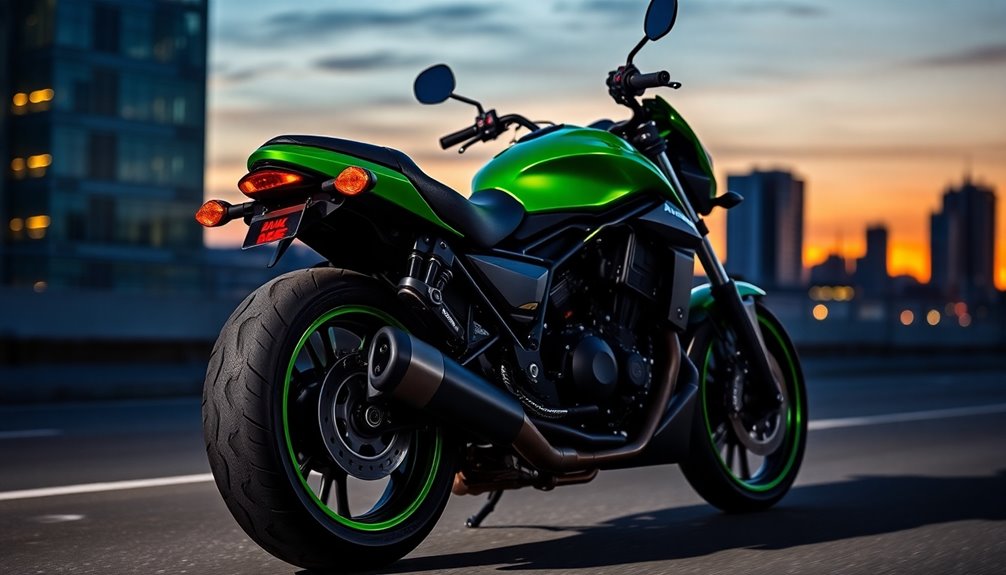
Performance enhancements and customizations for the Kawasaki Vulcan S can significantly elevate your riding experience. You can start by considering engine modifications.
With its Ninja 650-derived engine, you're already getting a solid 61 PS @ 7500 rpm. An ECU flash or aftermarket exhaust system can give you a bit more power, while removing restrictions in certain countries can unlock the full potential of 61 HP. This can drastically reduce your 0-100 km/h time, improving acceleration from 6.59 seconds to just 4.82 seconds.
Next, think about transmission and gearing. The 6-speed manual transmission allows you to tweak your riding style. Adjusting the chain sprockets can enhance low-end torque or high-speed performance, giving you more control on the road. However, keep in mind that sprocket alterations can lower top speed and affect speedometer accuracy.
Don't overlook suspension and handling. You can adjust the preload on the rear single-shock to improve stability or cornering agility.
Additionally, the dual-channel ABS enhances braking safety, ensuring you're confident at every stop.
Competitive Pricing Options
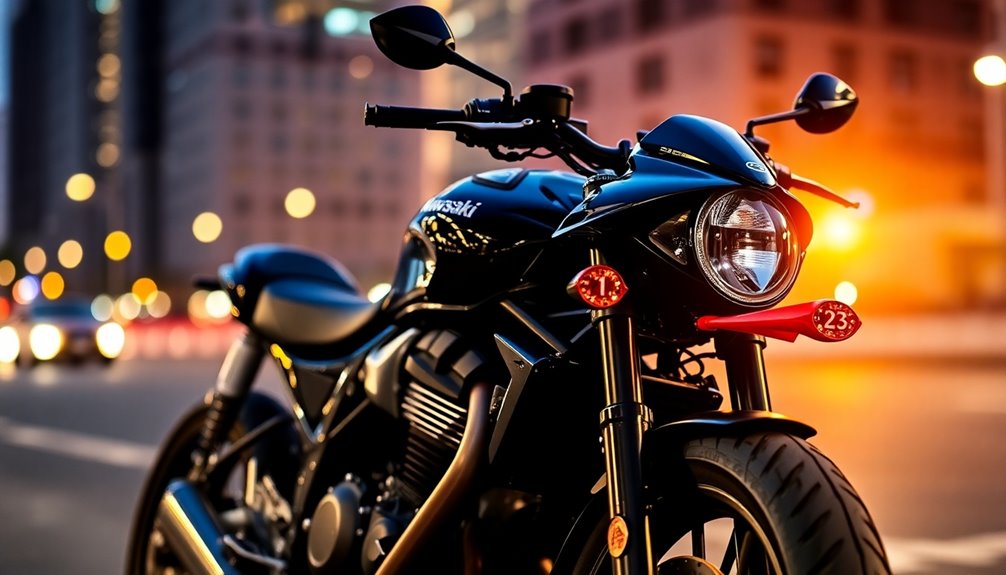
When you're considering the Kawasaki Vulcan S, you'll find that its competitive pricing options make it an attractive choice for riders. The base model starts at about $7,349, with the non-ABS variant slightly higher at $7,399. This pricing is on par with other cruisers in the market, offering excellent value for money.
If you prefer added safety, the ABS version is available for around $7,749, with the MSRP at $7,899. It's a minor price increase for enhanced safety, making it a smart investment. The Vulcan S is powered by a 649cc liquid-cooled engine, providing a blend of performance and efficiency.
For those looking for something special, the Vulcan S ABS Cafe model comes in at $8,499, featuring two-tone paint, signature tank badging, and a dark-tinted wind deflector. These higher trims bring more aesthetic and functional upgrades, reflecting their added features.
Keep in mind that prices can vary based on location, and additional costs for destination, freight, and customization may apply. Accessories like saddlebags and windscreens can further personalize your ride, but they'll come at an extra cost.
Adventure-Seeking Urban Riders

For adventure-seeking urban riders, the Kawasaki Vulcan S presents an ideal blend of style, comfort, and performance. You'll find this bike to be a perfect companion for both city commutes and weekend getaways.
As you explore scenic routes, consider joining local motorcycle clubs or groups through platforms like Meetup.com. These communities often gather at popular motorcycle hangout spots, so you can easily connect with fellow riders.
Enhance your skills by attending off-road riding schools or adventure bike rallies, where you'll meet experienced riders who can share valuable tips. Participating in organized group rides not only helps you gain confidence but also introduces you to diverse riding experiences, and you'll find that the support network established during these rides is invaluable in case of emergencies.
When planning trips, use GPS tracks from group rides to navigate new terrains smoothly. The Vulcan S's adjustable ergonomics ensure comfort on longer journeys, while its performance specs provide the power you need for varied road conditions.
Don't forget to document your adventures and share your experiences with the community, as this fosters connections and enriches your riding journey. Whether you're seeking thrills or camaraderie, the Vulcan S and the adventure-riding community have got you covered.
Frequent Tire Wear Challenges

Frequent tire wear challenges can often catch riders off guard, leading to premature tire replacements and compromised safety. One significant factor is tire pressure; if it's too low, your tires will wear unevenly and generate excess heat. Regular pressure checks are essential, especially before long rides, as low tire pressure can lead to poor handling and increased tire wear. Additionally, the total weight you carry—including passengers and cargo—plays a crucial role in how quickly your tires wear down.
Road conditions also impact wear patterns. Uneven surfaces, weather conditions, and a road's crown can all contribute to accelerated tire degradation. The type of tire compound matters, too; softer compounds provide better grip but wear out faster, while harder compounds last longer but may sacrifice traction.
Your riding style affects tire longevity as well. Maintaining a centered riding position and distributing loads evenly can help prevent uneven wear. Regularly checking tire pressure and conditions is vital for catching wear issues early.
Lastly, adjusting your suspension settings can significantly improve tire life; fine-tuning preload and damping can help distribute loads evenly and maintain consistent tire contact with the road. Proper suspension settings may also help mitigate the effects of improper tire pressure on tire wear and handling.
Robust Braking System Features

Riders often appreciate the Kawasaki Vulcan S's robust braking system, which is designed for reliability and performance. The bike features a single 300mm front disc brake paired with a twin-piston caliper and a single 250mm rear disc brake that comes with a single-piston caliper. This setup provides reliable stopping power, effective at all speeds and in various riding conditions.
You'll find that the brakes inspire confidence, offering good control despite the motorcycle's weight. The engine braking significantly contributes to overall stopping power, perfectly balancing the bike's robust engine performance. The braking system is further enhanced by the optional Anti-lock Brake System (ABS), ensuring better control and safety during emergency stops. Additionally, the engine shared with Versys 650 contributes to the Vulcan S's impressive performance metrics.
Additionally, the integrated suspension system, featuring a 41mm telescopic front fork and adjustable rear shock, enhances the overall ride quality. This combination allows the brakes to work harmoniously with the suspension, providing a smooth and stable experience, whether you're navigating city streets or cruising on the highway.
With these features, you can trust that the Vulcan S has your back when it comes to stopping power and rider safety.
Impressive Handling at High Speeds
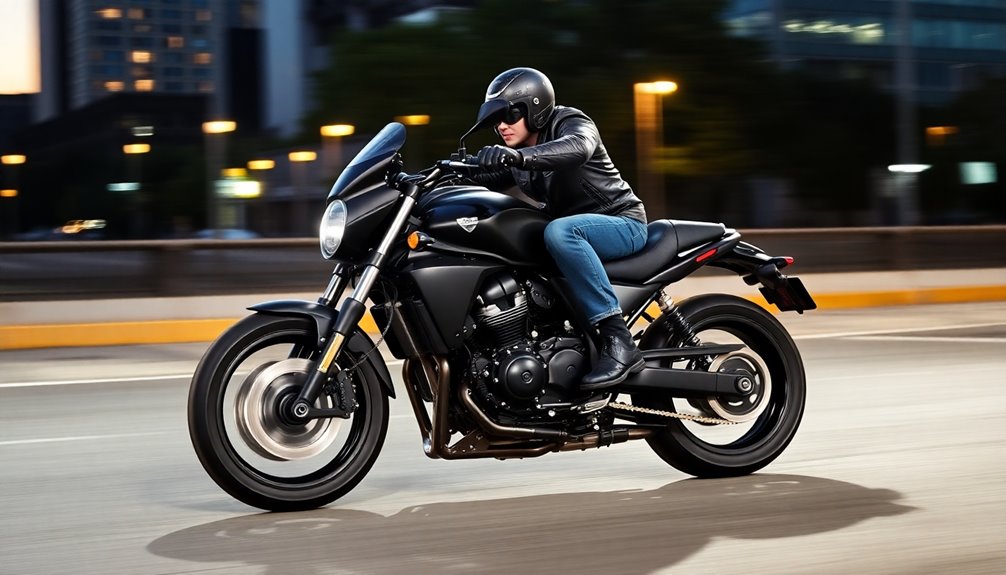
The Kawasaki Vulcan S impresses with its handling at high speeds, making it a standout choice for those who crave both performance and stability. With a top speed of 116.8 mph, you'll find that most riders comfortably achieve real-world speeds between 108-110 mph. The 649cc parallel-twin engine delivers 61 hp and 46.5 lb-ft of torque, providing smooth power across the rev range, particularly favoring midrange acceleration for highway overtakes.
The bike's sportbike-derived chassis and suspension contribute to its light, responsive handling. With a low seat height of just 27.8 inches, maneuverability at slow speeds is enhanced, while stability remains strong even at high speeds. You'll appreciate how the bike feels stable and predictable, especially when cruising between 65-80 mph with minimal vibrations. The Vulcan S has remained largely unchanged since its debut in 2015, showcasing its enduring appeal.
Although there's a slight flat spot in power delivery, it's hardly noticeable as you push through the gears. You'll also benefit from the adjustable rear shock, which allows you to fine-tune your ride for comfort and preference.
Frequently Asked Questions
What Is the Kawasaki Vulcan S's Engine Size and Type?
The Kawasaki Vulcan S features a 649 cc engine, which is a parallel-twin configuration.
This 4-stroke engine offers solid performance with a maximum power output of 61 horsepower at 7,500 rpm and a torque of 46.3 lb-ft at 6,600 rpm.
It's liquid-cooled and utilizes a dual overhead cam (DOHC) system, ensuring efficient operation.
With a compression ratio of 10.8:1, you'll find it delivers a balanced mix of power and fuel efficiency.
How Does the Vulcan S Compare to Other Cruisers in Fuel Efficiency?
When you compare the Vulcan S to other cruisers, you'll notice it offers decent fuel efficiency, averaging around 44 mpg under normal conditions.
While the Harley Davidson Street 750 boasts better mileage at 58 mpg, the Vulcan S's parallel-twin engine delivers impressive power.
Its optimized fuel usage, especially when following Kawasaki's ECO indication, can push your efficiency to about 50 mpg, making it a solid choice for both city and highway riding.
What Color Options Are Available for the Kawasaki Vulcan S?
You'll find the Kawasaki Vulcan S offers a variety of color options over the years.
For 2023 and later, you can choose the striking Pearl Matte Sage Green.
If you're interested in special variants, the Café ABS features a sleek metallic matte dark gray with red accents.
Keep in mind that color choices may vary by region, so check with your local dealer for the most accurate options available to you!
Is the Kawasaki Vulcan S Suitable for Beginner Riders?
Yes, the Kawasaki Vulcan S is great for beginner riders.
Its 649cc engine offers smooth and predictable power, making it easy to handle. With a low seat height of 27.8 inches, you'll find it accessible and comfortable.
The adjustable ergonomics allow you to customize the fit, while the lightweight design enhances maneuverability, especially in city traffic.
Plus, optional ABS provides an extra layer of safety as you develop your riding skills.
What Is the Warranty Coverage for the Kawasaki Vulcan S?
The warranty coverage for the Kawasaki Vulcan S is quite comprehensive.
You get a standard warranty of 24 months, with an option to extend it up to 4 years.
With Kawasaki Protection Plus, you can add 12 to 48 months of coverage beyond the limited warranty, with no mileage restrictions.
This protection covers major components like the engine, transmission, and electrical systems, plus offers roadside assistance and transferable coverage, enhancing resale value.
